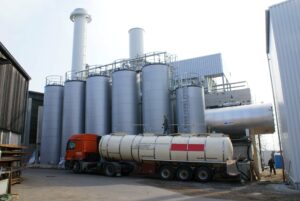Biofuels – a story without a happy end
By Ariel Brunner and Trees Robijns, BirdLife Europe – partially based on the analysis of the Commission’s Globiom study carried out by Transport & Environment (T&E)
Biofuels have been promoted in Europe since the early 2000s. In the beginning, they were touted as a magic potion: saving emissions, ensuring energy security in Europe and helping farmers find new markets for their products. After 15 years of obfuscation, back room lobbying and political paralysis, one study after another has shown that this has been nothing but a dead end, one littered with environmental, social and climatic wreckage. As the EU debates its climate and energy polices post 2020, the painful history of a bungled policy should guide decision makers towards a fresh way of thinking.
On the policy side, it all started in 2003 when the EU put forward a biofuels directive with indicative targets: 2% biofuels by end 2005 and 5.75% by end 2010. This directive was repealed in 2009 by the Renewable Energy Directive (RED) setting in place a target of 10% of renewables in the transport sector by 2020 (and a wider 20% renewables in the EU’s overall energy consumption). This was completed by the Fuel Quality Directive (FQD) with a 6% decarbonisation target also by 2020. After a big push, especially by the European Parliament, a limited set of sustainability criteria linked to biofuels and bioliquids were added to the targets with the aim of only stimulating sustainable forms of biofuel.
During the preparation of these directives, NGOs already sounded the alarm bells. Be it from an environmental or greenhouse gas saving perspective, there was little good to be found in biofuels. When NGOs did their analysis after the renewable energy legislation came into place, they concluded that “meeting the 10% transport target using mainly biofuels would require a combination of a large increase in the area of land devoted to biofuel crops and an unprecedented increase in the intensity of farming”. They asked for “sustainability criteria in EU law to be redefined to ensure that all environmental and social impacts be taken into account, thereby promoting only those biofuels bringing genuine overall benefits.”
Not just biofuels were highlighted as problems by NGOs at the time – scandals emerged on biogas where for example excessive German subsidies for biogas transformed whole Natura 2000 sites into maize deserts. Another case has been the one of solid biomass, especially wood, where European green certificates have prolonged the life of several coal power plants, as in the UK and Belgium. These plants are now reliant on burning whole trees shipped from the other side of the world (such as the South-East US) on the false pretense that they deliver green electricity. The commission took no action on either of these two bioenergy forms, preferring the “let’s wait and see” approach to the precautionary principle.
Even as problem after problem became known and as a broad scientific consensus formed, no genuine changes to the directives were proposed and the Commission only zoomed in on their limited political mandate related to the so-called “Indirect Land Use Change” (ILUC). As per the RED, “the Commission shall, by 31 December 2010, submit a report to the European Parliament and to the Council reviewing the impact of indirect land-use change on greenhouse gas emissions and address ways to minimise that impact. The report shall, if appropriate, be accompanied, by a proposal”. A piece of research was commissioned from the International Food Policy Research Institute (IFPRI) by the European Commission to « produce a more detailed and reliable estimate » of indirect land-use change. IFPRI would finally form the basis of further policy discussions and decisions. However, it almost took court action by the NGOs to get the study released.
The politics behind the discussions were very difficult. After evidence appeared that ILUC could indeed make biofuels even worse for the climate than fossil fuels, the Commission came out, after almost two extra years of delays, with a proposal for a 5% cap on first-generation biofuels (made from agricultural crops). The policy sausage making machine finally settled on a 7% cap on biofuels from agricultural crops and some marginal additions on so-called advanced biofuels. However, the discussion around biofuels and ILUC carried on and the Commission continued to commission studies.
Now, over five years after the original IFPRI report came out and after the Commission’s statement in its Communication on the 2030 climate and energy policy framework that ‘food-based biofuels should not receive public support after 2020’, another element has been added to the saga. A new study was commissioned, this time from another consortium using another model (Globiom) to estimate the true emissions related to biofuels.
As if history was repeating itself, release of the study was again delayed for a long time. Both industry and NGOs had to put in access-to-document requests and MEPs wrote open letters to get access to the publicly funded information. Finally, when the study went public – too late to inform the Commission’s public consultation on the reform of the Renewable Energy Directive – the information only gave a partial idea of the emissions of biofuels [1]. Environmental NGO Transport & Environment made a more complete analysis of the facts, taking into account the full life-cycle emissions linked with the feedstocks analysed in Globiom.
So as we stand, this is what we know:
- Emissions from biodiesel are actually 81% higher than those arising from fossil fuels.
- On average, first-generation biofuels have 50% higher lifecycle GHG emissions than fossil equivalents so phasing them out would reduce transport emissions significantly.
- Instead of reducing CO2 emissions, using biodiesel for transport could increase Europe’s overall transport emissions by almost 4%. These extra emissions are equivalent to putting about 12 million additional cars on Europe’s roads in 2020. It’s a lot more than the emissions saved from all lorry road charging systems in Europe, for instance.
- Ethanol performs better, but offers limited GHG savings while still increasing the pressure on the environment through intensive farming and interfering with food markets.
- Advanced biofuels (not from agricultural crops) score very well emissions wise, but have consistently failed to gain any significant market share or attract serious investment. This is mainly because EU and member state incentives support first-generation biofuels thereby outcompeting better technologies.

Meanwhile Europe’s bioenergy policy is wasting 8 million ha of agricultural land on biofuels production and even more on feedstocks for biogas (e.g., in 2012, Germany’s biogas hunger resulted in over 1.1 million ha of land going to crops such as maize for biogas alone). On top of this, it is driving a rapid increase in imports of feedstocks ranging from palm oil to wood.
After a decade and a half of foot dragging and obfuscation, the case is settled. The EU biofuels policy has been bad for the climate, bad for nature and bad for people. And the same is true for its wider approach to bioenergy in general. It is now time to move on. This is no longer just about palm oil or wood pellets, this is about what we burn as renewable energy, in which amounts will it save emissions and tackle climate change and whether or not it will have negative environmental and social consequences.
The Commission must stop playing the same old tricks, confront reality and come up with a policy framework that limits the use of bioenergy and pushes only those feedstocks and technologies that deliver real sustainable energy.
For further information, please contact: Ariel Brunner or Trees Robijns
[1] http://birdlife2014stage.birdlife.org/sites/default/files/attachments/fuellingcrisis.pdf and http://www.transportenvironment.org/press/biofuels-targets-are-dangerous-dead-end
[2] http://www.actionaid.org/sites/files/actionaid/fuel_for_thought.pdf and http://www.biofuelwatch.org.uk/category/reports/biofuels-and-climate-change/ and http://www.birdlife.org/europe-and-central-asia/biofuels
[3] http://www.transportenvironment.org/what-we-do/what-science-says-0
[4] ILUC are indirect emissions caused by market mechanisms. If a farmer was previously growing food on his land and now uses the land to grow fuel instead, we can ask how the demand for food is now met. This demand can either be met by growing the food elsewhere or food prices have increased so much that people will eat less and hence the demand for food “disappears”.
[5] Globiom only focuses on the land use change emissions related to the biofuel feedstock and thereby does not give a full picture of whether or not the biofuel feedstock in question is saving emissions.
Banner photo: Corn field (c) Keeva999, Flickr Creative Commons



